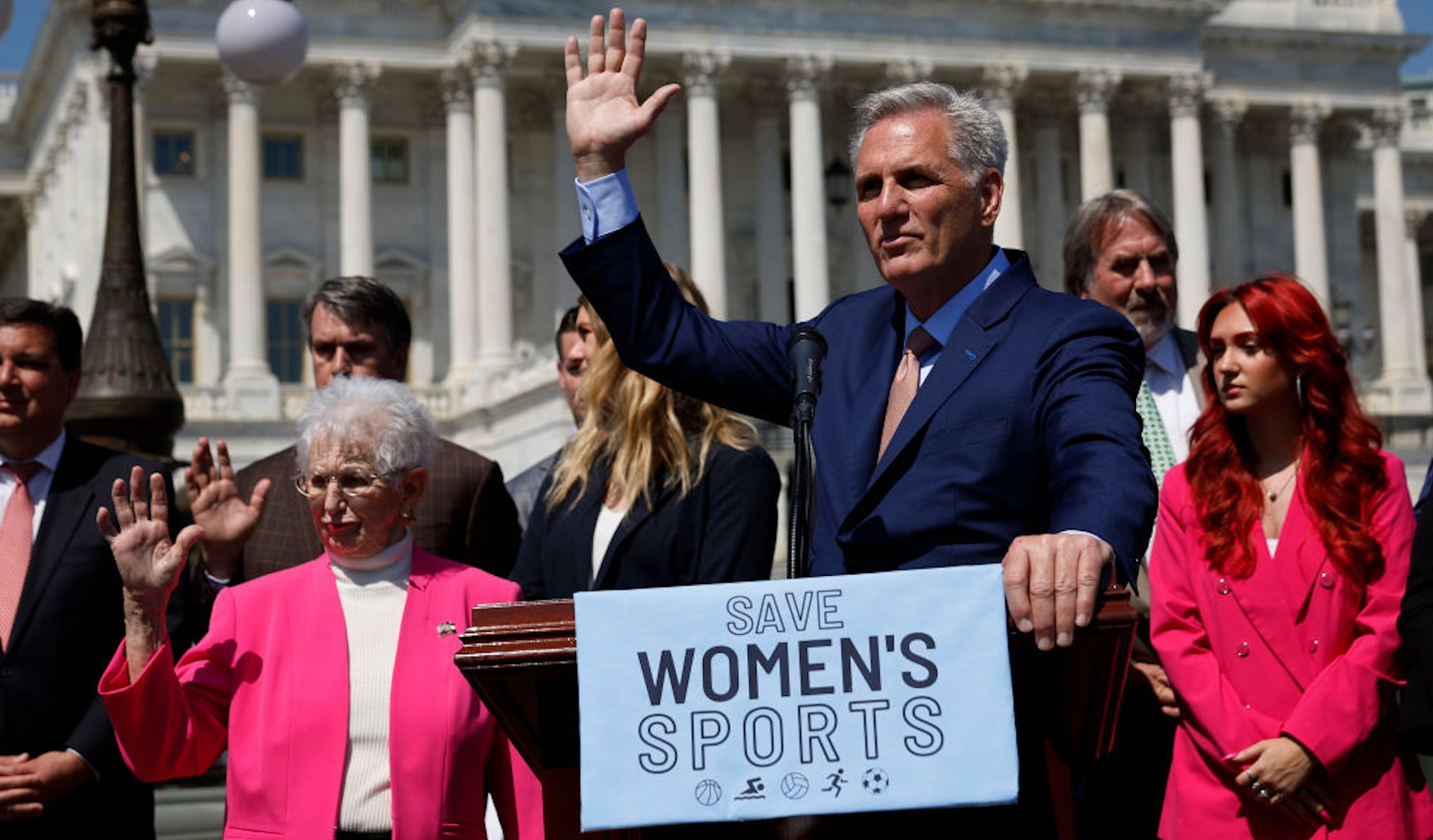On Jan. 14, the U.S. House of Representatives passed a bill that would ban trans girls and women from every level of sport, in every state in America. The text of the cynically titled “Protection of Women and Girls in Sports Act” is as vague and confused as the roughly 25 state laws that already ban trans kids from sports, but it remains striking for its scope. This bill applies not just to college-aged athletes, but also to kids as young as kindergarten.
Supporters of the legislation really, really want you to believe this is all about fairness. It’s in the name of the bill: Banning trans women would protect cis women athletes (somehow). In affirming his support, California Rep. Doug LaMalfa expressed outrage at the idea that “XY chromosome males” were currently “taking the place of women and girls in sports,” an analysis of the current situation that is just as darkly conspiratorial as it is bogus.
We should not even take this bill on its own misleading terms. First, the question of fairness has never been a particularly honest one. Sports is not a pure meritocracy. Every athlete has different levels of advantage and disadvantage, and for the most part, we take them for granted. Certain bodies inherently provide advantages in certain sports; Michael Phelps has an out-of-proportion wingspan that just happens to be perfect for swimming. Other structural advantages determining who can access and succeed in sports—namely, class—go almost entirely unexamined. As Katie Barnes points out in their book Fair Play: How Sports Shape the Gender Debate, upper-middle-class kids who can pay for specialized coaching have automatic advantages over their peers. “The reality of sports is that we accept unfairness all the time,” Barnes writes. The fact that trans women and girls, for whom there is no evidence of advantage anyway, are the sole targets here underscores that this is not about leveling a playing field—this is about demonizing a community.
In fact, what this federal bill has done is take a conversation that has been unfolding for decades in elite sports, decontextualize it, and apply it to all school sports—to intramural college basketball as well as second-grade soccer. These are sports where the competitions are more about building a social community than they are about winning. Many of these kids would not consider themselves athletes in the strict sense; they play because they want to have fun and make friends. Writing trans girls and women out of these spaces is purely about exclusion—it’s an attempt to push trans people out of fundamental parts of American public and social life.
Republicans have not really bothered to consider how they would enforce such a sweeping sports policy if it passes. This week, when a reporter asked Michigan Republican Tim Walberg to explain how trans girls would be identified and weeded out of school sports, he replied that the legislation “doesn’t deal with that.” The dozens of state-level and local-level bans on trans athletes already in effect don’t offer a much clearer picture, except that the brunt of enforcement has fallen on individual schools—and, really, on individuals themselves. In Nassau County, N.Y., a legislator who supported a recent ban on trans girls in sports squarely put the responsibility to identify and remove trans girls from sports teams on coaches. “I would hope that the coach has enough sense to say, ‘Look, we’re not playing the rest of this game,’” the legislator said, and then added, cryptically, that active enforcement from coaches would mean the “police don’t have to be called.”
What this will surely inaugurate is a system of informal surveillance, where coaches, parents, and peers will scrutinize girls’ bodies and perceived femininity in search of anyone not quite cis. While trans girls are the unquestioned target of this legislation, all girls who fail to embody a strict standard of femininity will feel its impacts. We saw this over the summer, when noted transphobe J.K. Rowling referred to Algerian boxer Imane Khelif as being a “male”; we saw this, too, in 1936, when American sprinter Helen Stephens was accused of being a man shortly after she won her gold medal. Some of these statewide bans have floated more aggressive surveillance mechanisms. The original version of Ohio’s trans athletes ban called for genital inspections as a way to determine a kid’s eligibility for school sports. The language was later removed, but it shows how far legislators are willing to go in order to block trans girls and women from sports.
And, really, let’s be honest here—enforcement is not the goal. This legislation is designed to frighten, to keep trans girls from ever even trying to join a sport, and, perhaps more to the point, to keep trans girls from coming out as trans at all. The troubling thing about this legislation, if it becomes law, is that its biggest repercussions will unfold just outside the frame. We won’t know the names of the trans kids who decide not to pursue sports because of the scrutiny they are sure to face, or who put off transitioning in the first place because doing so would jeopardize their chance at an athletic scholarship.
We saw this in the 1960s through the 1980s, when the Olympics began defining female athletes as only those with XX chromosomes. Elite women whose chromosomes were not XX disappeared quietly. They either failed a test ahead of the Olympics and dropped out, claiming injury, or they were told as kids that there was no point in pursuing higher levels of competition. The sports doctor Albert de la Chapelle, a critic of the IOC’s sex testing policies, wrote a letter in the 1980s about a young female skier who was found to have XY chromosomes. Her coach told her to quit sports. “This woman represents the invisible part of the iceberg: those numerous unfortunate women who are subjected to sex chromatin screening and eliminated from sports long before they reach a major competition,” de la Chapelle wrote. “There must be hundreds if not thousands of women who have been silently shuffled aside this way.” We are about to see this happen again on a massive scale, and we won’t even know it.
For all of the bluster from conservative lawmakers, this isn’t really about sports at all. These bans, in fact, are a kind of right-wing cultural land grab, the opening salvo in an effort to redefine what it means to be a man and a woman along purely natalist lines. To see what could be coming next, look at Oklahoma. In 2022, state legislators passed an early ban on trans women athletes. Oklahoma Republicans then used their momentum to ram through a “Women’s Bill of Rights” that created narrow legal definitions of man and woman. Tellingly, the law defined “female” based solely on the body’s reproductive potential: A female is someone with a reproductive system that produces eggs for fertilization, the legislation stated, and a male is someone who creates sperm. A man was necessarily a male; a woman was necessarily a female. In one move, in other words, Oklahoma entirely erased trans people from its legislative policies.
Underpinning all of these laws is a core belief that bureaucracy can definitively sort man from woman—that biological sex is stable and straightforward, that we know a woman when we see one, that we don’t have to concern ourselves with all of this messy gender business. None of this actually makes any sense. Sex is an interplay of chromosomes, genitalia, hormones, and much more, and there’s no single measure that automatically distinguishes male from female. If we’ve learned anything from the 80-year history of sex testing at the Olympic level, it is that there is no simple way to cleave people into binary categories. The Olympics has cycled through different markers—genital exams, chromosome tests, hormone tests—and never successfully found one. Even Alexandre de Mérode, the long-suffering head of the IOC’s Medical Commission, once admitted that “it was practically impossible, scientifically, to define the sex of an athlete.”
These realities are of little concern to the Republican right. If conservatives have their way, laws like Oklahoma’s, which impose stringent definitions of man and woman, would become federal policy. In November, a Kansas representative introduced a similar bill into the U.S. Senate. These efforts are designed to write trans women, trans men, and nonbinary people wholesale out of public life. The right wing has taken sports, an issue on which they feel they are gaining rhetorical ground, and used it to launch a much greater campaign against trans people. The logic is simple: Once you normalize removing an entire group of people from one key part of public life—like school sports—it’s much easier to advance more violent policies, like blocking basic healthcare access. The sports ban is about laying the groundwork for this mass dismantling of rights.
Going forward we should forcefully and directly counter these misleading claims about athletic advantage. We should emphasize that access to sports is a human right. This conversation is always framed around whether it’s fair for trans women and girls to compete in sports. We should be framing the question as: Is it fair to exclude trans women and girls from sports? But we should also be honest about what is happening here. This legislation is not about sports, really—it is a pretense to ram through very narrow and conservative ideas about what it means to be a man and woman. It is a work of ideological theater that sets the stage for violently stripping away rights from trans people across all parts of public life.






